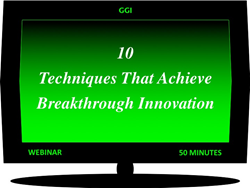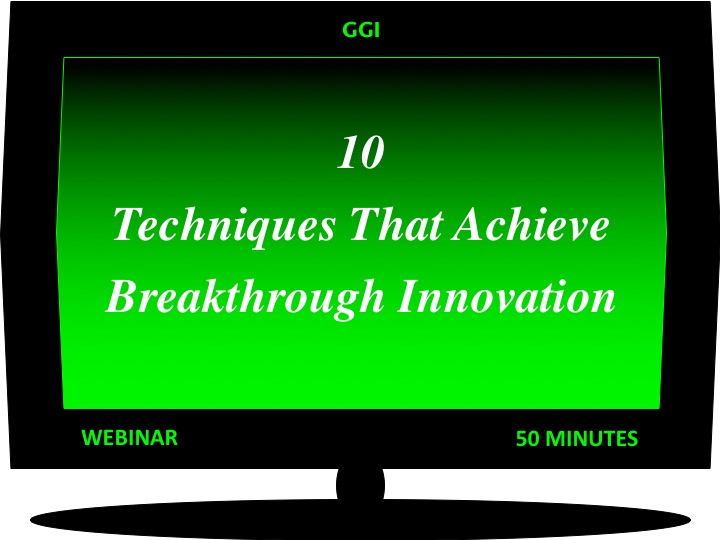
10 Breakthrough Innovation Techniques
Professional, well structured, well thought out. Thought provoking and content rich. Plenty of take-aways. — R&D Director, Millipore
NEEDHAM, Mass. (PRWEB)
December 27, 2019
In an economic uptick, there are more resources to deploy. Spending goes up. More things are possible. Alternatives increase. How do you choose wisely?
Out-innovating the competition, smart R&D decisions and spending, and distinct value-enhancing product design and packaging are three topics that get a lot of time in the board room and offices of corporate leaders. We address each of these subjects with a three-hour Mini-Series consisting of three one-hour programs.
The Innovation Performance 10-9-8 Series
10 Techniques That Achieve Breakthrough Innovation: This program focuses on ten differentiable techniques that have evolved since Clayton Christensen first coined “Disruptive Innovation” in the 1990s. These ten techniques are all disruptive in some way across the spectrum of disruption: Breakthrough, Disruptive, Radical, Transformational, New-To-The-World, New-To-The-Industry, and Next Generation.
9 KPIs That Capture Innovation Performance: This program focuses on nine Key Performance Indicators (KPIs) that together capture the lion’s share of overall innovation performance. These nine KPIs span investment levels, innovation levels, execution ability, productivity, and overall business performance.
8 Practices That Boost Corporate Innovation: This program focuses on eight processes, tools, and techniques that are known to increase innovation creativity and execution, and/or the value of investments in innovation, in corporations. Some are strategic and soft in nature, such as communication and messaging. Some are tactical, such as combining products and IP in business plans. Others are process-oriented and spur raw innovation or the early detection of errors.
The R&D Spending Performance 8-8-8 Series
8 Conditions That Impact R&D Spending Results: This program focuses on factors that will negatively impact spending and spending performance. Some of them are controllable, some are not. We discuss eight conditions ranging from spending decisions in boom and bust periods, to overspending and underspending, to the impacts of variable spending and negative events on output and productivity, that lessen output and outcomes.
8 Metrics That Quantify R&D Spending Performance: This program focuses on key performance indicators [KPIs] that have R&D spending in their calculation. The metrics range from corporate metrics that are either reported to Wall Street or used by analysts and CFOs, to measures that help to divvy-up funds across business units of different purposes and performance levels, to measures that improve the ranking of investments, to measures that can be used to modulate overspending or underspending for corporate and industry considerations.
8 Actions That Increase R&D Spending Output: This program focuses on factors that will positively influence spending and spending performance. All of them are within your control. Does your company have its arms around these? We describe eight actions ranging from good CXO behaviors, to data sciences and digital posturing, to timing new product announcements and actively competing for awards, that increase output and outcomes.
The Product Design Value 7-6-7 Plus Series
7 Ways To Create Value With Product Design: This program focuses on opportunities to design-in capabilities that will enhance the appeal and increase the value of products from their point of purchase throughout the product’s life cycle. We will discuss seven different opportunities, and quantify the size of the economic opportunity for each. The least opportunity represents a 20% increase in revenues unto itself. The several large opportunities represent upwards from 200% increases in revenue and profit from the same design effort. The Plus in this 7-6-7 Series program will touch on how miniaturization of design, next generation motors, and a couple more topics will also begin to influence product design.
6 Ways To Reap Value From Product Design: This program focuses on opportunities to increase the value of products, portfolios, and brands that have been robustly designed, or are well along to that goal. We will discuss six different opportunities, and quantify the size of the economic opportunity for each. These opportunities all have double-digit potential to increase revenues and profits, and single digit for market cap. In some cases, incremental monies will be needed to realize the augmentation potential of the design or design-leverage ability. The Plus in this 7-6-7 Series program will cull-out selected awards and recognitions for good product design, as distinguished from the multitude of award and recognition program categories existing today.
7 Measures To Value Product Design: The third program focuses on measures that characterize or quantify good design in the eyes of customers and users. While some measures also have utility for internal purposes such as product quality, reliability, and cost, this program centers on how customers, users, markets, and the investor community regard the products. We discuss seven different KPIs that range from codifying the quality and robustness of ID and UX designs, to metrics that gauge pricing gross margins and potential market value, to indexes that provide for cross-market comparisons and market cap premiums. The Plus in this 7-6-7 Series program will briefly touch on several other metrics relevant to good product design including customer satisfaction, completion rates, NPS, and others.
Program Leader
Founded in 1986, Bradford Goldense’s company has consulted to over 200 medium and large companies. Some 500 companies have participated in GGI’s educational events. Since 1998 the company has performed primary and secondary research on R&D, product development, innovation, and metrics. For twenty years, Brad also taught in the weekend executive Masters in Engineering Management program at The Gordon Institute at Tufts University. Mr. Goldense is a cited author in over three-hundred publications, many of which may be found in Google Scholar and ResearchGate.
Licensing
Corporate Licenses are now a value at three times the single-user price. Positive actions on any of the 10-9-8, 8-8-8, and 7-6-7 group of topics can make or save tens of thousands of dollars apiece, even if only implemented once. A short license statement accompanies each video transmittal. There is nothing to sign.
Share article on social media or email:

